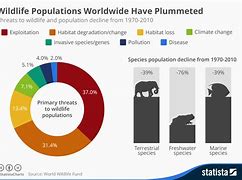Context:
Recently, the World Wildlife Fund (WWF) released its 2024 Living Planet Report (LPR), revealing alarming trends in global biodiversity.
Key Findings of the Report
Measuring Nature’s Decline:
The Report highlights that since 1970, the average size of monitored wildlife populations has decreased by 73%.
- This decline extends 35,000 wildlife populations and 5,495 species of amphibians, birds, fish, mammals and reptiles.
From 1970 to 2020, freshwater species experienced the steepest decline at 85%, followed by terrestrial species at 69% and marine populations at 56%.
At a regional level, WWF highlighted the steepest declines in Latin America and the Caribbean, where populations have dropped by 95%, followed by Africa, which has seen a 76% decline.
- The Asia-Pacific region experienced a 60% decline in wildlife populations.
- In contrast, Europe faced smaller declines, while Central Asia and North America saw drops of 35% and 39%, respectively.
Key Drivers: include habitat degradation and loss, overexploitation of resources, pests and invasive species.
- Climate change has led to population declines in Latin America and the Caribbean, while pollution is the main cause in North America, Asia, and the Pacific.
The report warns that continued trends could lead to catastrophic consequences, destabilizing the Earth’s life support systems.
Dangerous Tipping Points:
- Coral Reef Bleaching: Ongoing mass coral reef bleaching affects over 75% of the world’s reefs, nearing critical tipping points that threaten coastal communities and biodiversity.
- The Amazon rainforest tipping point would release tonnes of carbon into the atmosphere and disrupt weather patterns around the globe.
- In ocean circulation, the collapse of the subpolar gyre, a circular current south of Greenland, would dramatically change weather patterns in Europe and North America.
- In the cryosphere (the frozen parts of the planet), the melting of the Greenland and West Antarctic ice sheets would unleash many metres of sea level rise, while large-scale thawing of permafrost would trigger vast emissions of carbon dioxide and methane.

Global Goals and Progress
- More than half of the United Nations-mandated Sustainable Development Goals (SDG) for 2030 are unlikely to meet their targets, with 30% of them either already missed or worse off than their 2015 baseline.
- National climate commitments would lead to an average global temperature increase of almost 3°C by the end of the century, inevitably triggering multiple catastrophic tipping points.
- National biodiversity strategies and action plans are inadequate and lack financial and institutional support.
Sustainable Solutions
Transforming conservation: Supporting Indigenous Peoples and local communities is key to large-scale biodiversity conservation, as they manage, use, or occupy about a quarter of the world’s land.
Transforming the food system: Promote sustainable, nature-positive food production by optimizing crop yields, livestock productivity, fisheries, and aquaculture, ensuring both food security and ecological balance.
- Reduce food waste, as 30-40% of food is wasted globally, accounting for 25% of total calories, 20% of agricultural land and water use, and 4.4% of greenhouse gas emissions.
Transforming the energy system: Energy production and consumption are the main drivers of climate change, severely affecting people and ecosystems. To limit warming to 1.5ºC, we must rapidly transition from fossil fuels to renewable energy, halving emissions by 2030.
Also Read:
19th International Conference of Drug Regulatory Authorities

